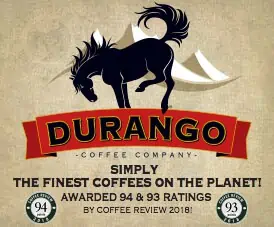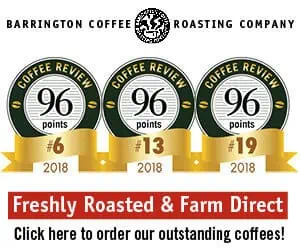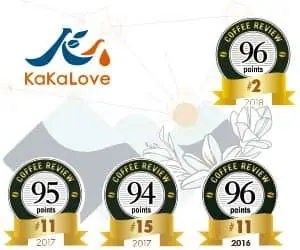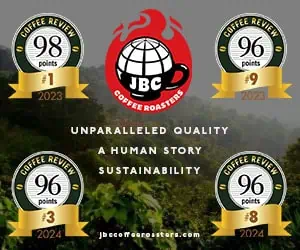A quietly dramatic coffee with a long development, in which a clear if understated acidity gives way to a sudden sweet lift in the cup, and nutty, pungent (perhaps smoky) notes are balanced by vanilla sweetness. All of the complex gestures remain in balance, and a silky smoothness envelops even the potentially sharp pungency.
Aromatic and gently complex. Delicate, sweet-vanilla nose. In the demitasse smooth, balanced body and well-nuanced flavor, with pungent chocolate modulating to sweet chocolate in the finish. Slight fruit flourishes. Tends to fade in milk, but retains a light, pleasingly fruity chocolate character.
Not nearly as dramatic as the Olympic mountains, but satisfying and substantial. Straightforward, low-toned, agreeably balanced, vibrant and solid in mid-range, fresh and sweet in finish, complicated by a touch of intrigue that could be called chocolate. As the cup cools the sweet tones grow rounder, fuller and more distinctly chocolate.
Reactions to this coffee ranged from enthusiasm to mild approval to ambivalence. The enthusiasts and mild approvers both tended to cite gently bright acidity, full body, and nut-toned aromatics. The enthusiasts felt the coffee brought power to the cup ("packs a punch"), while the approvers felt it didn't ("mild, mild, mild; sweet and soft cup"). The ambivalencers also honored the virtues of the coffee, but detected a slight shadow taint. One suggested that the sample was a bit "faded," another "baggy." Both adjectives suggest this otherwise meticulously clean coffee suffered very mild damage, perhaps moisture-related, during transport or storage.
Judging by their comments, this Old Tavern Jamaica Blue Mountain peaberry was the clear favorite of the majority of the panelists, although they assigned slightly higher numbers for some cupping categories to the regular-bean Old Tavern also reviewed. Descriptions for this peaberry suggest a brightly yet sweetly acidy coffee, with floral high notes, full body, and good dimension. Some reviewers gushed ("Packs a punch! Love it"; "The nicest coffee of this Caribbean cupping. An outstanding flavor"); others simply approved or ho-hummed as they did with all of these coffees. I didn't pick up the hint of storage-related flatness that muted the regular-bean Old Tavern, although some reviewers did, groping to describe it with terms like "faded" and the like. I contributed some help to Alex Twyman, the farmer who developed the Old Tavern coffees, so my own assessment may be suspect, but on the basis of two rounds of rigorously blind cupping I agree strongly with the yea-sayers. I found this a clean, vibrant, subtly complete coffee.
Pungent chocolate in the nose. Slightly sharp in the cup, with distinct tobacco notes and a hint of dry chocolate. Solid body but little resonance.
This coffee manifested some brightness and acidity in the cup, which probably accounted for a higher rating than one would expect given that several panelists complained of a background shadow or taint. I called the problem a "slight, high, hard fruitiness." Another cupper identified it as grassiness; another detected a "rubbery" taste; still another concluded the coffee was "faded." Not much consensus in those descriptions, but clearly something was off. Two of us noted that the profile tended to vary from cup to cup, with some cups bright with a floral or fruit-toned acidity, and some dulled by the elusive taint.
Something was slightly off with this coffee. Two panelists mentioned ferment but I doubt it. One called the taint grassy; "slightly harsh & earthy" wrote another; I had it as "a touch of hard tobacco, herb." Whatever it was, it brought down the rating of this otherwise ingratiatingly sweet, rounded coffee with subtle grace notes variously described as chocolate, vanilla, and (the favorite) caramel.
I found this coffee quite impressive when hot, with the sort of resonant dimension and long, gradually sweetening development I admire. However, for me the profile turned a bit grassy and hard as it cooled. The rest of the panel didn't have much to say about this coffee one way or the other. A few complaints surfaced suggesting roughness or hardness; one panelist reported "good intensity/balance, [though] not enough intensity for my taste." It would appear that a lack of character rather than taint or weakness doomed this coffee to a relatively low rating.
Although this is not quite the deep, almost syrupy sweet Haitian coffee I recall occasionally tasting before Haiti's latest run of political misfortunes, it is a good coffee, and a very promising one, given the relative newness of the admirable Cafeieres Natives project. On the upside, sweet, ingratiating aromatics. Three panelists called these high, delicate notes floral; three others mentioned cocoa or chocolate; one mint. The more tactile aspects of the cup disturbed some, however. Two used the word "gritty"; one "muddy." I found the cup (with patience) rich, but opaque and without dimension or resonance.
Another coffee whose assessment was dominated by roast issues. In this case, seven of eight panelists objected that the sample was roasted a bit too light. However, this complaint was offered as an aside to generally approving appraisals of the coffee itself. A general picture emerges of a well-prepared, clean coffee, sweet and balanced, with hints of fruit and nut. "Aroma of Spanish peanuts carries through to the flavor," concluded one panelist. "Pleasantly focused cup." Given the tone of approval in written comments, I can only assume that this coffee was not rated higher because it lacked power and dimension.
A straightforward coffee, nicely balanced, clean and free of taint except (perhaps) a slight grassiness, a shadow note possibly encouraged by the rather light roast. Panelists noted nutty tones in the aroma and a hint of chocolate in the finish ("cocoa-like" specified one). Why wasn't this fundamentally centered, pleasant coffee not rated higher? Only one panelist registered enthusiasm. I suspect a lack of what some call power and I call dimension -- the sense of unnamed, resonant sensation opening behind the initial impression.
No outright defects were cited for this Jamaican coffee, but panelists found little to praise. "No there there," wrote one; "mild to a fault," wrote another. The only panelist to give this coffee a decent rating praised its sweetness and balance. Three detected a slight off taste, applying outdoorsy terms like grassy and woody to it, terms that suggest the coffee may not have been rested long enough after drying.
The most thoughtful assessments of this coffee characterized it as a potentially powerful but flawed coffee. "Although a little bit grassy, maybe due to lack of 'reposo' [resting the coffee after processing], this is a very good coffee," concluded one panelist. "Interesting undomesticated flavors," offered another. "One of those coffees that makes me scratch my head and say 'You're different, but do I really want to know you better?'" On the upside panelists cited this coffee's sweet fruit and richness. On the downside it elicited terms like weedy, oniony, or soapy. The most comprehensive attempt at describing the off-taste cited "Aromas of dried onions, grains and soy-sauce."
The majority of panelists dismissed this coffee as fermented, the flavor defect that results from the some of the beans picking up the rotten-fruit taste of fermenting sugars during processing or drying. "Trying to be constructive here but can't find any grounds for redemption," wrote one. However, three panelists were open to redemption, rating this coffee in the low 80s, perhaps reading the ferment tones as fruity or wine-like. Two of the three yea-sayers struggled with their ambivalence in their comments, finally coming down on the positive side of the fruit/ferment continuum. The matrix of sensation under and around the ferment definitely was full and complex.
Comments on this coffee focused almost exclusively on the issue of roast: This particular sample was roasted considerably darker than the other samples in the cupping. This dark style, atypical for cupping purposes, was deliberate: The very experienced Coffee Review roaster concluded that this coffee came across best at a darker roast. However, six of eight panelists complained that the roast was too dark to permit fair evaluation. For this reason we are not publishing a rating for this coffee. The sample certainly was clean and free of defect. Whether it manifested enough power to stand up to a darker roast is another question.










